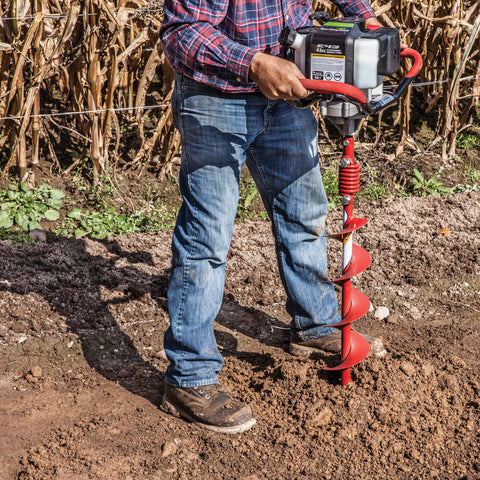What Size Earth Auger Do I Need?
Choosing the correct auger size may save you a lot of extra work on your drilling project. Depending on the application, a hole that is either too large or too small may not work at all. We've laid out the important factors to consider as well as some of the most practical auger sizes for common jobs.

Post Holes-
When drilling holes for posts, it is important to consider what additional support your posts may need. If you plan to secure your posts with cement or by tamping dirt, you will need spacing around the post to do so. For example: A 4x4 post (actual size 3.5"x3.5") has a maximum width of just over 5" (diagonally). Therefore, the 4x4 post will likely fit into a hole drilled by a 6" diameter auger. However, this leaves less than 1/2" at the widest part for cement or dirt to be packed in to secure the post. For this reason, an 8"-10" auger would work much better and provide the necessary fill space for cement or tamping.
When planning a project like fencing or deck posts, it is also important that you are able to align the posts to be perfectly inline and level. If a hole is drilled just big enough to fit your post, you have no room for error when it comes to aligning your holes. However, a hole that is at roughly twice as wide as your post will allow you to move that post within the hole to align it with the others. In addition, the extra space tolerates slightly angled holes that are common for first time users. This ability to adjust can save you lots of headaches on your project.
Recommendations:
| 1 7/8" Steel Post | 6" Auger |
| 2 3/8" Steel Post | 6" Auger |
| 4x4 Wood Post (Mailbox) | 8" Auger |
| 4x4 Wood Post (Fence) | 10" Auger |
| 6x6 Wood Post | 12"+ Auger |
Planting
Planting with an earth auger can be an extremely efficient and effective way to plant anything from bulbs to potted trees. The size of the auger required depends heavily on what you are planting, your soil conditions and your geological location.
A 2"-4" auger is capable of quickly and efficiently drilling large numbers of holes suitable for seeds, bulbs or small potted plants.

Larger potted plants are generally measured in gallons and the width of the pots varies slightly. The general sizing rules are as follows:
Bulbs - 2", 3" or 4" Depending on bulb size
1 Quart Pot - 6"
1 Gallon Pot - 8"
2 Gallon Pot - 8"
3 Gallon Pot - 10"
5 Gallon Pot - 12"
When planting professionally or in large quantities, you may want to consider a purpose built planting auger. Earthquake Planting Augers are designed to drill a tapered hole shape that better matches the shape of the pot to reduce air gaps and make backfill quick and easy. Learn more about Earthquake Planting Augers.
The required hole size also depends on the type of soil you are planting in. Hard packed soil can inhibit root growth. To combat this condition you may want to drill an oversized hole. This breaks up the hardpacked soil and the leftover fill is likely more suitable for root expansion. In contrast, when planting in a tilled garden, the hole size may only need to be large enough to fit the existing root system since the surrounding soil is already in good condition.
Smaller Augers (2"-4")
Smaller augers are generally used for jobs such as soil sampling, anchoring, seeding and some railing installs. While larger augers can also be used for this same purpose, the smaller augers offer several benefits. Smaller augers put less stress on the user and require less dirt refill once the railing or anchor is installed.
Note: Projects requiring an earth auger (such as decks and fences) may require you to follow local codes and regulations when it comes to hole width and depth. Always be aware and follow local regulations. Call 811 before digging to make sure all utility lines are clearly marked.
